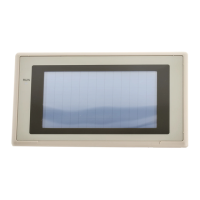2-1SectionPT Screens
42
The PT allows up to 8 screens to be displayed overlapped as one screen. A
group of overlapped screens is called overlapping screens.
To allow distinction, the screen onto which the multiple component screens are
overlapped is called the parent screen and the individual component screens
are called the child screens.
Both parent screens and child screens can be registered under any screen num-
bers in the range 1 to 3999. Note that a new screen must be designated as a
parent screen.
Parent screen Child screen
Screen No. 10
This are
Screen No. 8
Screen No. 7
This are
overlapping
screens.
Screen No. 25
overlapping
screens.
Child Screen Registration and Display Result
Child screens are created as normal (standard) screens. Therefore they can
also be displayed independently by designating their screen numbers.
Parent screens are special screens used for the purpose of displaying overlap-
ping screens. They are created by designating a new screen as a parent screen
at the Support Tool. Register only the screen numbers of the child screens to be
overlapped for this new screen. Direct registration of elements on a parent
screen is not possible.
To display overlapping screens on the PT, designate the screen number of the
parent screen. The child screens will be displayed in the order they were regis-
tered (i.e., the first one registered will be the bottom-most screen) to build up the
compound image.
Note that the order in which the child screens are registered may affect the way
that overlapped screens are displayed.
Child screen 1
Registration order:
Child screen 1 → Child screen 2
Child screen 2
Registration order:
Child screen 2 → Child screen 1
Restrictions on Overlapping Screens
Note the following points, when creating overlapping screens.
• Numeral input and character string input fields, which allow the input of numer-
ic values and character strings, can each only be set on one of the child
Overlapping Screens

